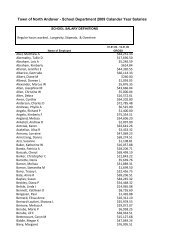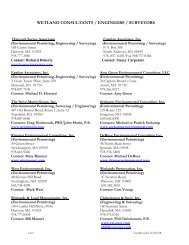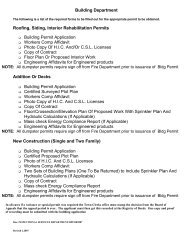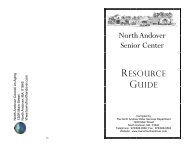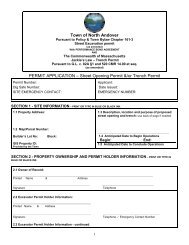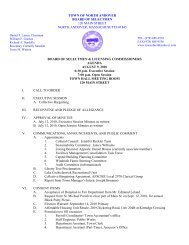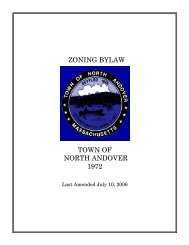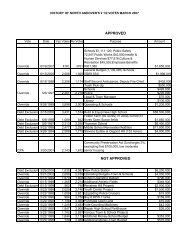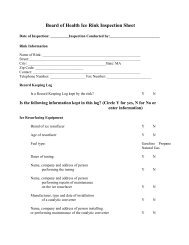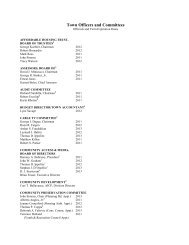to view the Affordable Housing Plan - Town of North Andover
to view the Affordable Housing Plan - Town of North Andover
to view the Affordable Housing Plan - Town of North Andover
Create successful ePaper yourself
Turn your PDF publications into a flip-book with our unique Google optimized e-Paper software.
and <strong>to</strong>wn houses only by right in <strong>the</strong> R5 district and by special permit in <strong>the</strong> B2.<br />
Opportunities <strong>to</strong> expand housing o<strong>the</strong>r than single family should be expanded by allowing<br />
more options as a matter <strong>of</strong> right. The goal is <strong>to</strong> create alternative housing choices such as<br />
triplexes, duplexes, <strong>to</strong>wn houses, condos, apartments, multi-family dwellings, etc. and<br />
housing developments for specific needs (i.e. senior housing and for disabled individuals).<br />
This will help <strong>to</strong> increase housing choice for middle-income residents.<br />
• The <strong>Town</strong> should consider density bonuses for providing affordable housing in mixed use<br />
developments (this would be above what may be required if <strong>the</strong> <strong>to</strong>wn adopts inclusionary<br />
zoning). Three market units for every additional affordable unit is consistent with what is<br />
required under 40B and could be used as a starting point.<br />
• Develop comprehensive design requirements for residential development. Design criteria<br />
should be established that maintain or improve architectural integrity, address signage issues,<br />
improve pedestrian and bicycle amenities, require landscaping, require small setbacks,<br />
encourage parking <strong>to</strong> <strong>the</strong> rear <strong>of</strong> <strong>the</strong> buildings, etc. Design is important when considering<br />
higher density because it helps ensure that neighborhood or community characteristics will<br />
be adhered <strong>to</strong> and maintained. This assists in community acceptance <strong>of</strong> <strong>the</strong> higher density as<br />
well.<br />
VII B - ADOPT AN INCLUSIONARY ZONING BYLAW<br />
Inclusionary zoning is a technique in which developers are asked <strong>to</strong> provide a certain number <strong>of</strong><br />
affordable dwelling units when <strong>the</strong>y are creating market rate units. A growing number <strong>of</strong><br />
communities in Massachusetts have turned <strong>to</strong> this zoning <strong>to</strong>ol as a way <strong>to</strong> increase <strong>the</strong> affordable<br />
housing s<strong>to</strong>ck. Examples include Arling<strong>to</strong>n, Belmont, Cambridge, Dennis, Duxbury, Haverhill,<br />
Peabody, Rockport, and Tewksbury. Inclusionary zoning would work well as a complement <strong>to</strong><br />
adopting an Open Space Cluster Bylaw.<br />
Under inclusionary housing, a minimum percentage <strong>of</strong> affordable units are <strong>to</strong> be provided when<br />
development proposals exceed an established threshold. These affordable units can be targeted for<br />
those individuals earning less than 120% <strong>of</strong> <strong>the</strong> median household income, and would be deed<br />
restricted <strong>to</strong> ensure long-term affordability. Progress <strong>to</strong>ward meeting affordable housing goals can<br />
be maintained through such a zoning provision only if <strong>the</strong> affordable units are provided for those<br />
households earning 80% <strong>of</strong> median household income or less.<br />
This could be one <strong>of</strong> <strong>the</strong> most effective and direct means for creating affordable housing units in<br />
<strong>North</strong> <strong>Andover</strong>. At a minimum, it will prevent <strong>the</strong> <strong>to</strong>wn from losing ground in <strong>the</strong> production <strong>of</strong><br />
affordable units as new market rate ones are built. Moreover, as discussed in detail below, it could<br />
create additional units <strong>to</strong> assist <strong>the</strong> <strong>Town</strong> in meeting <strong>the</strong> 10% 40B goal. Such a bylaw is fair if<br />
written properly and applied across <strong>the</strong> board, and since it is initiated by <strong>North</strong> <strong>Andover</strong>, it places<br />
more control in <strong>the</strong> <strong>to</strong>wn’s hands as opposed <strong>to</strong> <strong>the</strong> developer’s. Finally, if <strong>the</strong> <strong>Town</strong> adopts<br />
inclusionary zoning, it will have more <strong>of</strong> a competitive edge for discretionary state grant programs<br />
scored under <strong>the</strong> Commonwealth Capital program.<br />
Several important policy decisions need <strong>to</strong> be considered including <strong>the</strong> percentage <strong>of</strong> units that<br />
should be required <strong>to</strong> be affordable; what threshold should be established <strong>to</strong> invoke <strong>the</strong> requirement<br />
<strong>North</strong> <strong>Andover</strong> <strong>Affordable</strong> <strong>Housing</strong> <strong>Plan</strong><br />
Page 39 <strong>of</strong> 49




